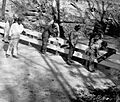Atlanta's Berlin Wall facts for kids
Quick facts for kids Atlanta's Berlin Wall |
|
|---|---|
| Part of the Civil Rights Movement | |

An image of the barricade
|
|
| Date | December 17, 1962 – March 1, 1963 |
| Location | |
| Caused by |
|
| Resulted in |
|
Atlanta's Berlin Wall, also known as the Peyton Road Affair or the Peyton Wall, was an important event during the Civil Rights Movement in Atlanta, Georgia, in 1962. On December 17, the city government of Atlanta, led by Mayor Ivan Allen Jr., built a barricade in the Cascade Heights neighborhood. This wall, mostly along Peyton Road, was put up to stop African Americans from moving into the area. Many African American leaders and civil rights groups strongly criticized this action. On March 1 of the next year, a judge ruled that the barricade was against the law, and it was removed. This event showed how much some white Americans in Atlanta feared racial integration.
Contents
Why the Wall Was Built
Cascade Heights is a wealthy neighborhood in southwest Atlanta. In the early 1960s, more and more African American families started moving into this area. In December 1962, Clinton Warner, a veteran and civil rights activist, bought a house in Peyton Forest, which was a white part of Cascade Heights.
After this, some white homeowners in the neighborhood became worried. They feared that more African Americans would move in. This led to a situation called "blockbusting." This is when real estate agents encourage people to sell their homes quickly because they say a different racial group is moving into the neighborhood. Then, these agents sell the homes to the new group for a higher price.
City Leaders and the Barricade
Because of these fears, white homeowners asked Atlanta's Mayor Ivan Allen Jr. to build a barrier. They wanted it along Peyton Road and Harlan Road to keep more African Americans from moving into the area. The Atlanta Board of Aldermen (city lawmakers) approved their request on December 17. Mayor Allen signed it into law that same day, and work on the barricade began the next day.

Rodney Mims Cook Sr. was one of the few aldermen who voted against building the barricade. He spoke strongly against the wall. The barricade was part of a bigger plan by Mayor Allen to prevent Black families from moving into white neighborhoods in southwest Atlanta.
What the Barricade Looked Like
The "wall" was actually a short barricade, about 3 feet (1 meter) tall, made of wood and steel.
Protests Against the Wall
As soon as the barricade was built, the African American community in Atlanta spoke out against it. Some newspapers called it "Atlanta's Wall." Black Atlantans often called it "Atlanta's Berlin Wall." This name was very meaningful because the city's mayor, Ivan Allen Jr., had once said that Berlin showed what happens to a divided city. Protesters used slogans like, "We want no Warsaw Ghetto – open Peyton Road." They wanted to show how racial separation in the U.S. was similar to the divisions seen during the Cold War and the Holocaust.
African Americans organized a boycott in West End, Atlanta, avoiding businesses that supported the barricade. People also picketed (protested) at Atlanta City Hall. Groups like the Committee on Appeal for Human Rights (COAHR), the Student Nonviolent Coordinating Committee (SNCC), and the Atlanta Committee for Cooperative Action (ACCA) worked together to protest the wall.
Leaders like Martin Luther King Sr. and the president of the Atlanta chapter of the NAACP said the barricade was "one of Atlanta's gravest mistakes." Many news outlets across the United States, including Jet and Time, reported on the event.
The Wall Comes Down
On January 7, 1963, Atlanta's city lawmakers voted to keep the barricade. However, the lawyers who were against the wall took their case to the Fulton County Superior Court.
Finally, on March 1, 1963, a judge ruled that the barrier was against the law. The judge said the decision to build the barricade was "unreasonable, arbitrary, and capricious" (meaning it was unfair and not based on good reasons). Within minutes of the judge's decision, Mayor Allen ordered the barricade to be removed. It had been in place for 72 days.
What Happened After
After the barricade was removed, the neighborhood continued to change. More middle class African American families moved into the area. This also led to more white flight from Atlanta. White flight is when many white families move out of a city or neighborhood, often to suburbs. By July 1963, only 15 white families remained in the neighborhood.
The incident also brought national attention to race relations in Atlanta. During the 1960s and 1970s, about 160,000 white Americans moved from Atlanta. Today, Cascade Heights is home to many successful African American families. The event also changed how the city government dealt with segregation in city planning.
Mayor Allen was surprised by the strong criticism of the wall. Years later, in his autobiography, he admitted that he was "completely in error" for trying to solve the issue in such a "crude way." He said he should have sought more advice. Many people see this incident as a rare mistake by Allen, who is otherwise remembered for supporting civil rights.
Images for kids



